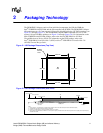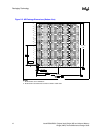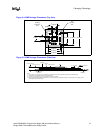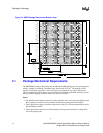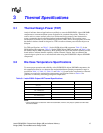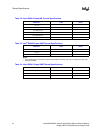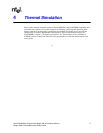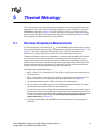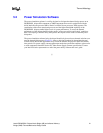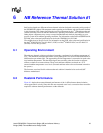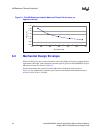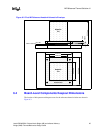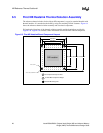
Intel
®
E8500/E8501 Chipset North Bridge (NB) and eXternal Memory 19
Bridge (XMB) Thermal/Mechanical Design Guide
5 Thermal Metrology
The system designer must make temperature measurements to accurately determine the thermal
performance of the system. Intel has established guidelines for proper techniques to measure the
NB/XMB die temperatures. Section 5.1 provides guidelines on how to accurately measure the
NB/XMB die temperatures. Section 5.2 contains information on running an application program
that will emulate anticipated maximum thermal design power. The flowchart in Figure 5-1 offers
useful guidelines for thermal performance and evaluation.
5.1 Die Case Temperature Measurements
To ensure functionality and reliability, the T
case
of the NB/XMB must be maintained at or between
the maximum/minimum operating range of the temperature specification as noted in Table 3-1 and
Table 3-3. The surface temperature at the geometric center of the die corresponds to T
case
.
Measuring T
case
requires special care to ensure an accurate temperature measurement.
Temperature differences between the temperature of a surface and the surrounding local ambient
air can introduce errors in the measurements. The measurement errors could be due to a poor
thermal contact between the thermocouple junction and the surface of the package, heat loss by
radiation and/or convection, conduction through thermocouple leads, and/or contact between the
thermocouple cement and the heatsink base (if a heatsink is used). For maximize measurement
accuracy, only the 0° thermocouple attach approach is recommended.
Zero Degree Angle Attach Methodology
1. Mill a 3.3 mm (0.13 in.) diameter and 1.5 mm (0.06 in.) deep hole centered on the bottom of
the heatsink base.
2. Mill a 1.3 mm (0.05 in.) wide and 0.5 mm (0.02 in.) deep slot from the centered hole to one
edge of the heatsink. The slot should be parallel to the heatsink fins (see Figure 5-2).
3. Attach thermal interface material (TIM) to the bottom of the heatsink base.
4. Cut out portions of the TIM to make room for the thermocouple wire and bead. The cutouts
should match the slot and hole milled into the heatsink base.
5. Attach a 36 gauge or smaller calibrated K-type thermocouple bead or junction to the center of
the top surface of the die using a high thermal conductivity cement. During this step, ensure no
contact is present between the thermocouple cement and the heatsink base because any contact
will affect the thermocouple reading. It is critical that the thermocouple bead makes
contact with the die (see Figure 5-3).
6. Attach heatsink assembly to the NB/XMB and route thermocouple wires out through the
milled slot.



